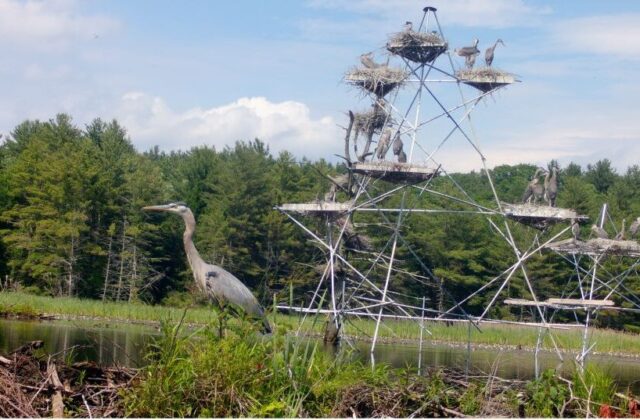great blue heron rookeries
working together to provide sustainable breeding habitats
By Jude Mead

The Great Blue Herons have come to roost at a rookery built recently on a beaver pond in South Norfolk.
Great Blue Herons are a familiar sight in Norfolk and are one of the largest of all North American herons, standing up to four feet tall with a wingspan of close to six feet. They are most noticeable in flight as they soar across the sky with their necks folded and legs trailing, leaving the viewer in awe of this large bird’s gracefulness. Though magnificent and conspicuous, the heron is vulnerable to many dangers including loss of habitat. Disturbance from human activities, pollution, and climate change threaten their nesting sites.
To ensure the welfare and sustainability of their breeding habitats, longtime resident Sue Frisch recently spearheaded an effort to add nesting sites to a heron rookery in South Norfolk. Frisch and a small group of neighbors received two grants along with donations of material to bring the project to fruition. “Shelley Harms suggested a grant to help buy materials, so I wrote the proposals. Connecticut Ornithological Association and AKC Fund donated money for one and two nesting tripods, respectively. The volunteers who set up the tripods were Wiley Wood, John DeShazo and Antonio Guindon, who also designed them. Fred Knight documented the rookery,” said Frisch.
A rookery is a collective nesting area where the Great Blue Herons nest in a group. The herons prefer to nest in tall trees located in standing water to protect themselves from predators. “We found the perfect location in South Norfolk on a beaver pond that had lost two of its original, occupied nesting trees. We waited until the pond froze, allowing us to walk out towards the center. There we drilled three holes through the ice and inserted long piping to form a tripod,” Frisch recalls. “It was then braced tightly to hold it in place and wooden frames were attached to host the nests that the herons would hopefully soon come to build.”
The herons usually arrive and begin construction of their nests by mid-March. weaving together large coarse sticks and branches to support their eggs and nestlings. “This can take several weeks, and the nests can measure up to two feet or more in diameter. The male comes first and either claims an existing nest or starts collecting sticks for a new one. To suggest nest building, we put sticks on the new nesting platforms,” said Frisch.

Rookery in South Norfolk attracts Great Blue Herons.
There can sometimes be six to eight or more nests on one platform. Although herons are known as solitary hunters, they nest together for safety reasons, keeping a dutiful eye for predators while raising their chicks. “For several months the parents feed and care for their offspring until they are old enough to survive on their own,” noted Frisch.
Seeing a rookery of nesting herons is exciting and it is important to safeguard this bird for generations to come. Frisch believes that Norfolk can act as a seed population for Connecticut, New York, and Massachusetts. So far, her group has erected three platforms in Norfolk and are planning a fourth. Others could do the same. Anyone having a suitable body of water in a protected area can put up a platform. When a small group of neighbors can commit a day to putting up a nesting platform, then anything is possible.
If interested in creating new habitat or in adding a nesting platform to an existing rookery that supports the Great Blue Herons, Antonio Guindon (toucan22@gmail.com) will be happy to advise. One place Frisch suggested for a platform was Great Mountain Forest.

